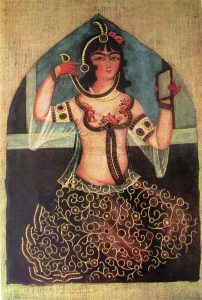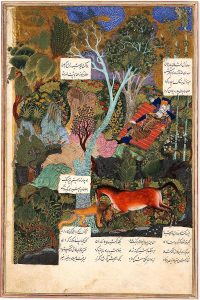Most historians believe that Islam originated in Mecca and Medina at the start of the 7th century CE, Muslims, however, believe that it did not start with Muhammad, but that it was the original faith of prophets, such as Jesus, David, Moses, Abraham, Noah, and Adam.

Image source: https://en.wikipedia.org/wiki/Muhammad#/media/File:Mohammed_receiving_revelation_from_the_angel_Gabriel.jpg
In 610 CE, Muhammad began receiving what Muslims consider to be divine revelations. Muhammad’s message won over a handful of followers and was met with increasing opposition from Meccan notables. In 622, a few years after losing protection with the death of his influential uncle Abu Talib, Muhammad migrated to the city of Yathrib (now known as Medina). With Muhammad’s death in 632, disagreement broke out over who would succeed him as leader of the Muslim community.
Muhammad, the last prophet

Image source: http://archive.jns.org/news-briefs/
Born in Mecca, in western Arabia, Muhammad (ca. 570–632), last in the lineage of Judeo-Christian prophets, received his first revelation in 610. Muslims believe the word of God was revealed to him by the archangel Gabriel in Arabic. These revelations were later collected and codified as the Qur’an (literally “recitation” in Arabic), the Muslim holy book. The Qur’an describes the relationship between an omnipotent and omniscient God and his creations. The Qur’an also maintains that all individuals are responsible for their actions, for which they will be judged by God, thus providing what are the guidelines for correct behavior in a just and equitable society.
Where do the resources come from?
The study of the early periods of Islamic history is made difficult by the lack of sources. The most important historical source for the origins of Islam is the work of al-Tabari who was an excellent historian by the standards of his time and place, yet the use of his work as a source is problematic for two reasons. For one, his historical writing style allowed the liberal use of mythical, legendary, stereotyped, distorted, and controversial presentations of his topic. Second, al-Tabari’s descriptions of early Islam post-date events by a long time, al-Tabari having died in 923.

Image source: https://en.wikipedia.org/wiki/Al-Tabari
How to deal with the available sources led to the development of four different approaches to the history of primitive Islam. All four methods now have some level of support. Nowadays, the popularity of the different methods employed varies according to the scope of the works under consideration. For general treatments of the history of primitive Islam, the descriptive approach is more popular. For scholars who look deeply into the beginnings of Islam, critical and traditional critical methods of the source are more often followed.
The Islam origins
Islam arose in the context of Late Antiquity. The second half of the sixth century saw political unrest in Arabia. Religious divisions played an important role in the crisis. Judaism became the dominant religion of the Himyarite Kingdom in Yemen after about 380, while Christianity took root in the Persian Gulf. Much of Arabia remained polytheistic but there was a desire for a more spiritual form of religion even though many were reluctant to convert to a foreign faith. On the eve of the Islamic era, the Quraysh was the main tribe of Mecca and a dominant force in western Arabia.

Image source: https://historyoftopfivereligions.wordpress.com/

Image source: https://en.wikipedia.org/wiki/Muhammad#/media/File:Kaaba_Masjid_Haraam_Makkah.jpg
According to tradition, the Islamic prophet Muhammad was born in Mecca around the year 570 and his family belonged to the Quraysh. At the age of forty, he began receiving divine revelations through the angel Gabriel, which would later form the Quran. These inspirations forced him to proclaim a rigid monotheistic faith, and warn of the imminent Day of Judgement, and punish the social injustices of his city. This message, however, won few followers and met with opposition from the notables of Mecca. In 622, after losing his protection with the death of his influential uncle Abu Talib, Muhammad emigrated to the city of Yathrib (later called Medina) where he was joined by his followers. Generations defined this event as the hijra, as the beginning of the Islamic era.
After Muhammad death: the four Caliphs
After Muhammad’s death, a series of four Caliphs ruled the Islamic state: Abu Bakr (632–634), Umar ibn al-Khattab (Umar І, 634–644), Uthman ibn Affan, (644–656), and Ali ibn Abi Talib (656–661). Known as the “Rashidun” or “rightly led” Caliphs in Sunni Islam. They oversaw the initial phase of the Muslim conquests, advancing through Persia, the Levant, Egypt, and North Africa.

Image source: https://www.bradford-delong.com/
Islamic art
Islamic art refers to the visual arts produced in the Islamic world including religious and secular art forms. Religious art is represented by calligraphy, architecture, and furnishings of religious buildings, such as mosque furnishing, woodwork, and carpets. The early development of Islamic art was influenced by Roman art, Early Christian art, and Sassanian art, with later influences from Central Asian nomadic traditions. Chinese art had a formative influence on Islamic painting, pottery, and textiles. Although the concept of “Islamic art” has been criticized by some historians the similarities between art produced in very different times and places in the Islamic world, such as the Golden Age, have been sufficient to maintain the term used by scholars.

Image sources: https://www.metmuseum.org/


Image source: https://en.wikipedia.org/wiki/Persianate_society

Image source: https://en.wikipedia.org/wiki/Persianate_society
Islamic art is characterized by recurring motifs, such as the use of floral or plant geometric designs in a repetition known as the arabesque, used to symbolize the transcendent, indivisible, and infinite nature of God. Errors in repetitions can be intentionally introduced as a demonstration of humility from artists who believe only God can produce perfection, although this theory is contested.
Calligraphy

Image source: https://en.wikipedia.org/wiki/

Image source:https://en.wikipedia.org/wiki/Islamic_calligraphy
Calligraphic design is ubiquitous in Islamic art, where religious exhortations can be included in secular objects, such as coins, tiles, and metal objects, and most painted miniatures include some script. The use of Islamic calligraphy in architecture significantly extended beyond Islamic territories. Two of the main scripts involved are the kufic and naskh symbolic scripts, which can adorn and enhance the visual appeal of the building walls and domes, minbars sides, and metalworking. Islamic calligraphy in the form of painting or sculptures is sometimes referred to as quranic art.
Info sources:
https://www.metmuseum.org/toah/hd/isla/hd_isla.htm https://en.wikipedia.org/wiki/History_of_Islam https://www.islamicity.org/8017/the-birth-of-islam/ https://en.wikipedia.org/wiki/Islamic_art
